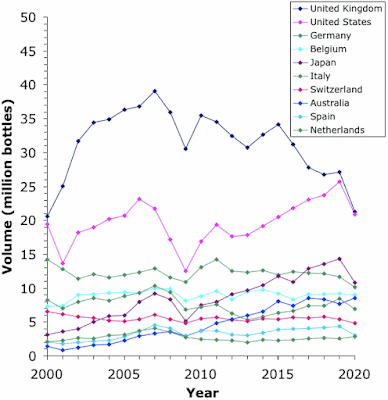However, pandemic-driven trends can be very misleading, if viewed in isolation. It is therefore worth looking at the long-term market patterns, which is what I will do here.
Annual data are available for each export market from the Comité Champagne. Here, I will look at the volume of exports (in millions of bottles) for each of the top 10 markets this century. These annual data are plotted in the graph, up until 2020. Note that I am covering only the export markets — France itself is far and away the biggest market for Champagne consumption.
Note, also, that the choice of these 10 export countries is based on their average purchases across the past two decades. In any given year, other countries sometimes made it into the top 10. For example, in 2020 Sweden was the 9th biggest export market, out-doing both Spain and the Netherlands. Indeed, Sweden has been a bigger market than the Netherlands since 2011, in spite of having only 60% of the population size.
As you can see in the graph, some countries have been relatively stable Champagne markets through time, including Germany, Belgium, Switzerland, Spain, and the Netherlands. Other markets have grown considerably, such as Japan, and Australia (and Sweden, as noted above). Italy has been a variable market, with a peak back in 2006–2008 (since which time their own sparkling wine has boomed).
The graph also makes obvious the effect of the pandemic, with a distinct export down-turn in 2020 compared to 2019. However, both Belgium and the Netherlands remained unchanged at that time — there were presumably no supply problems for these two nearest neighbors to the Champagne region itself. On the other hand, the only market to show a 2020 increase in imports was Australia, which is the furthest market away!
In a similar vein, the effect of the 2008 Great Recession is also obvious in the graph, with every single country showing a marked decrease in imports in 2009. Sales rebounded in 2010, in all cases, as I recently discussed in: Did US imported sparkling wine recover from the Great Recession?
Finally, the graph shows that the two biggest export markets have been the most variable of all, through time. Essentially, the pandemic put the United Kingdom back to where it was at the beginning of the century, having risen rapidly to a market peak in 2007, never to return. The dip from 2007 coincides with the Great Recession, after which exports continued at a lower level, until 2015. The subsequent decline seems to coincide with the Brexit shenanigans (and the rise of local sparkling wine production).
On the other hand, the USA, while remaining the second-biggest export market, has shown a continual increase in imports since the Great Recession. Champagne is obviously how you show recovery from a recession! Even without the pandemic, the forecast for 2020 would have put the USA and UK roughly equal as markets.
There was a distinct recovery of exports in 2021 (Everything you need to know about Champagne in 2021), although I do not have the complete data to put in the graph. The main point of note is that the exports to the USA (34 million bottles) easily exceeded those to the UK (29 million bottles) for the first time. Both of these figures exceed the 2019 numbers, the US one by a long way. This was not true for either Belgium or Australia (which were roughly the same as before), although in 2021 Germany imported more Champagne than it had since the turn of the century (15 million bottles).
Clearly, the UK still has a greater per capita Champagne requirement than does the USA — the US has nearly five times as many people as does the UK, and so the British are consuming five times as much Champagne, given roughly equal import volumes. Indeed, it seems that moves are afoot to change things for the UK (Champagne's hopeful vision of the future) (Tyson Stelzer on bringing Taste Champagne back for UK buyers).
Also, these are solely volume figures, of course. This tells us nothing about the quality of the wine being imported by each country. I covered this topic in a previous post: This is who drinks the priciest champagne. The UK chooses much more pricey Champagne than does the USA — more than 3 times the price, on average. So, in terms of total value, the UK still leads the country pair.
Indeed, for our chosen countries, the per capita volume of Champagne imported in 2020 was:
|
Country Belgium Switzerland Australia Sweden United Kingdom Netherlands Germany Italy Japan Spain United States |
Bottles / person 0.773 0.558 0.330 0.324 0.312 0.168 0.120 0.115 0.086 0.065 0.063 |




No comments:
Post a Comment